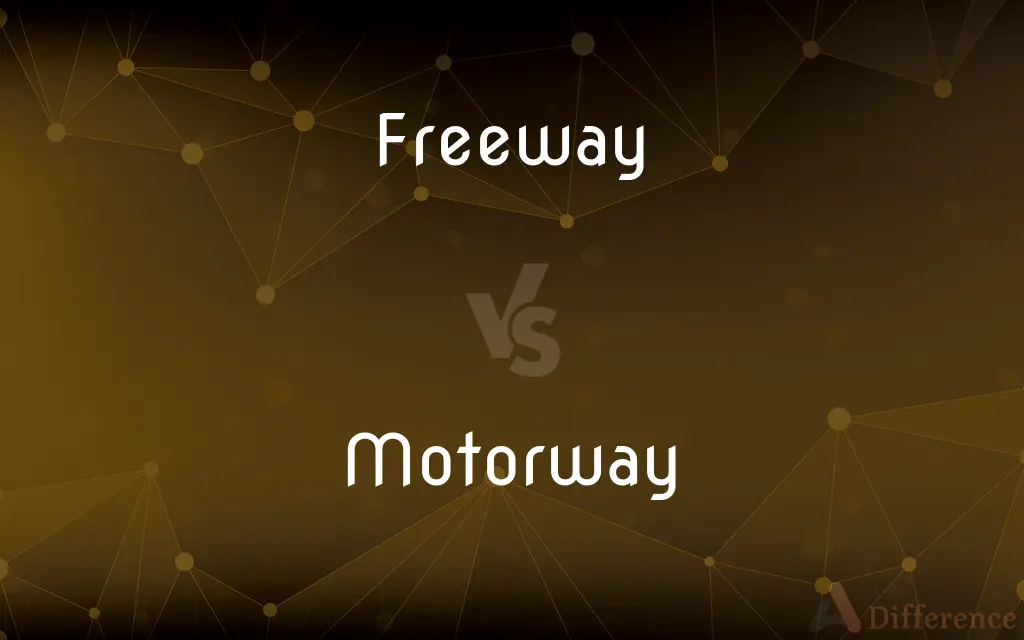Freeway vs. Motorway — What's the Difference?
By Tayyaba Rehman & Maham Liaqat — Updated on March 16, 2024
Freeways are high-capacity urban roads designed for fast traffic with no tolls or intersections, while motorways are major roads or highways designed for long-distance travel, often with controlled access.

Difference Between Freeway and Motorway
Table of Contents
ADVERTISEMENT
Key Differences
Freeways are typically found in urban or suburban areas, facilitating rapid movement across cities without the interruptions of traffic lights or intersections. These roads are characterized by multiple lanes and high speed limits, designed to maximize traffic flow and minimize congestion. Motorways, on the other hand, are extensive road networks that connect cities and regions, supporting long-distance travel and heavy freight movement. They are built to high specifications to ensure safety and efficiency at high speeds.
The term "freeway" is more commonly used in the United States and parts of Australia, denoting a road that is free of tolls and designed for uninterrupted traffic flow. Motorways, prevalent in the United Kingdom, Europe, and many Commonwealth countries, may or may not be tolled, but their defining feature is controlled access, meaning entry and exit are limited to designated points.
Freeways often have overpasses and underpasses to eliminate intersections, allowing for continuous travel without stopping. Similarly, motorways are designed to avoid at-grade crossings, but they also typically feature service areas or rest stops, providing amenities for travelers on long journeys. These service areas are less common on urban freeways, where exits to local services are more frequent.
Both freeways and motorways restrict certain types of vehicles, such as bicycles, pedestrians, and sometimes very slow-moving vehicles, to maintain safety and traffic flow. However, the specific restrictions can vary between regions and countries. For instance, some motorways may allow motorcycles but not bicycles, while some freeways may have dedicated lanes for high-occupancy vehicles or public transportation.
While the primary purpose of freeways is to improve urban mobility by connecting different parts of a city or metropolitan area efficiently, motorways serve as the backbone of national and regional transportation networks, facilitating trade, travel, and economic connectivity over greater distances.
ADVERTISEMENT
Comparison Chart
Location
Urban or suburban areas.
Connects cities and regions, often rural and urban.
Purpose
Rapid urban mobility, minimize congestion.
Long-distance travel, connect major cities.
Tolls
Typically no tolls.
May be tolled or untolled.
Access
Controlled with no at-grade intersections.
Highly controlled access, designated entry/exit points.
Common in
United States, parts of Australia.
United Kingdom, Europe, Commonwealth countries.
Vehicle Restrictions
No bicycles, pedestrians, slow vehicles.
Similar restrictions, may vary by region.
Design Features
Overpasses, underpasses, multiple lanes.
Service areas, rest stops, high specifications for safety.
Speed Limits
High, to facilitate rapid movement.
Also high, consistent with long-distance travel.
Compare with Definitions
Freeway
A divided highway with no tolls and no direct access to adjacent properties.
The 405 Freeway in Los Angeles is known for its heavy traffic.
Motorway
A long-distance highway, possibly with tolls, for efficient travel.
They're expanding the motorway to reduce travel time between cities.
Freeway
An urban road designed for fast traffic, with overpasses and underpasses.
The freeway system significantly improved commute times in the city.
Motorway
A major road designed for fast traffic, with limited access points.
The M1 Motorway is a key route between London and Leeds.
Freeway
A high-speed road without tolls, primarily in urban areas.
She took the freeway to avoid the downtown traffic.
Motorway
A road with high speed limits and service areas for travelers.
The motorway's service stations offer food, fuel, and rest areas.
Freeway
A multi-lane road in urban settings, facilitating rapid transit.
The new freeway has reduced congestion in the suburbs.
Motorway
A controlled-access highway connecting different regions.
The motorway network facilitates national trade and mobility.
Freeway
A toll-free, high-capacity road with controlled access points.
The freeway connects the city center to the airport efficiently.
Motorway
A major arterial road, part of the regional or national infrastructure.
The government plans to build a new motorway to boost economic growth.
Freeway
See expressway.
Motorway
A dual-carriageway road designed for fast traffic, with relatively few places for joining or leaving.
Freeway
A highway without tolls.
Motorway
An expressway.
Freeway
(In parts of Canada, the U.S. and Australia) A highway with grade-separated crossings (rather than level crossings) and designed (and only permitted) for high-speed motor-traffic running in two directions on one separate carriageway each
Motorway
(In Europe, New Zealand and parts of Australia) A highway with grade-separated crossings (rather than level crossings) and designed (and only permitted) for high-speed motor-traffic (in Europe motor vehicles with a higher speed limit than 40 km/h) running in two directions on one separate carriageway each
Freeway
A toll-free highway.
Motorway
(Chiefly in the U.S.) A racetrack venue designated especially for the sport of auto racing.
Freeway
A broad highway designed for high-speed traffic
Motorway
A broad highway designed for high-speed traffic
Common Curiosities
What's the main difference between a freeway and a motorway?
The main difference lies in their typical locations and purposes: freeways are usually urban, focusing on city mobility, while motorways are for longer distances, connecting broader regions.
How do urban planners decide between building a freeway or motorway?
The decision depends on factors like the intended purpose, location, expected traffic volume, and the overall transportation network plan, focusing on whether the priority is urban mobility or regional connectivity.
Can anyone drive on a motorway?
Motorways are generally accessible to all drivers, but some countries require a minimum driving experience or a special license for motorway driving.
What happens if there's an accident on a motorway?
Motorways often have emergency services and protocols, including emergency lanes, to manage accidents efficiently and minimize disruption.
How do freeways and motorways accommodate high-speed travel?
Both are designed with multiple lanes, high speed limits, and features like overpasses and underpasses to facilitate smooth and fast travel.
Are bicycles allowed on freeways or motorways?
Bicycles are typically prohibited on both freeways and motorways for safety reasons due to high-speed vehicular traffic.
Can you find tolls on freeways?
Generally, freeways are toll-free, though there are exceptions, especially in countries where the terms freeway and tollway are not strictly defined.
Are motorways safer than regular roads?
Motorways are designed to high safety standards and often have lower accident rates due to controlled access and the absence of intersections, making them generally safer than regular roads.
Do all countries use the terms freeway and motorway?
No, the usage of "freeway" and "motorway" varies by country, with some places using alternative terms like "expressway" or "highway" with similar meanings.
Can freeways and motorways reduce traffic congestion?
While they are designed to facilitate traffic flow and reduce congestion, high volumes of traffic and incidents can still lead to congestion on freeways and motorways.
Share Your Discovery

Previous Comparison
Workstation vs. Desktop
Next Comparison
ADP vs. ATPAuthor Spotlight
Written by
Tayyaba RehmanTayyaba Rehman is a distinguished writer, currently serving as a primary contributor to askdifference.com. As a researcher in semantics and etymology, Tayyaba's passion for the complexity of languages and their distinctions has found a perfect home on the platform. Tayyaba delves into the intricacies of language, distinguishing between commonly confused words and phrases, thereby providing clarity for readers worldwide.
Co-written by
Maham Liaqat













































